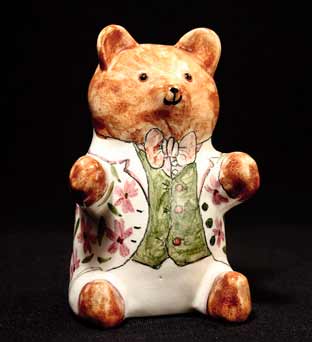
Cinque Ports de Bethel bear

Cinque Ports de Bethel bear
See also:
Cinque Ports de Bethel bear - 5" (127 mm) high.
de Bethel, Joan
Joan and David de Bethel started making papier maché cats and bears in 1960. They were intricately made and quite expensive - each piece took at least a day just to paint.
David died in 1977 and Joan took up an idea that they had been tossing around before his death; she got Rye Pottery to supply soft biscuit fired models, and she painted them and returned them to the pottery for the glaze firing. Many failures ensued as the ceramic paint smudges easily when dry and this made successful transportation of the pieces difficult.
Demand was high, and Joan had to go to Cinque Ports Pottery to augment the supply of bisque blanks. During a period of exceptionally high demand the Cinque Ports decorators had to help out by painting some pieces, and this led to Joan allowing Cinque Ports to produce their own models, very similar to hers. A change in the production technique followed. Instead of soft biscuit fired blanks Joan used hard fired biscuit and painted it with acrylic paint, finishing it off in marine varnish, eliminating the need for a further firing and the problem of smudging.
Items marked with the Cinque Ports backstamp and From a design by Joan de Bethel are wholly the work of Cinque Ports Pottery. Those marked JB © Rye are painted by Joan and glazed and fired by Cinque Ports. The models marked Joan de Bethel or Joan and David de Bethel are hand-painted and cold glazed (marine varnished) by Joan. All the papier maché items, of course, however marked, were hand made and decorated by Joan.
Following the demise of the Cinque Ports Pottery in July 2007 production of the blanks has moved to the David Sharp Pottery where Ben Sharp is carrying on with exactly the same arrangement that Joan had with Cinque Ports.
There is a strong collectors' market for de Bethel pieces. The ceramic ones fetch good prices and the papier maché originals realize very high prices. For someone who has not handled both types it is difficult to tell the ceramic and the papier maché apart - the papier maché are very hard and quite heavy - it's quite simple though; the papier maché models are solid at the base and the pottery ones are hollow. Similarly the Cinque Ports pieces are easy to tell from de Bethel's by the mark on the base. The pottery cats come in different sizes, the largest being about 7 inches (178mm) high.
Joan de Bethal has also been a designer for Rye Pottery, and is a respected painter of pictures.
Further Reading: | The Potteries of Rye, 1793 onwards by Carol Cashmore |
Cinque Ports Pottery
David Sharp left Rye Pottery in 1956 and formed Rye Art Pottery with his friend George Gray.
The name had to be changed, though, when Rye Pottery threatened legal action. They asserted, probably quite correctly, that customers would be confused by the similarity of the two names and not know whom they were buying from. Consequently Rye Art Pottery became Cinque Port Pottery.
The business was successful. George was the businessman and David the artist, and their combined talents produced a thriving company. In 1958, after the closure of Dicker Pottery, they bought the trade mark. They didn't use it, but more to the point, neither did anyone else.
By the start of the sixties they were using four kilns and employing 15 workers. The partnership became a Limited Company, with another small change of name. They became Cinque Ports Pottery Ltd. The plural 'Ports' was used because that is what most people called them, being more familiar with Cinque Ports as a collection of towns rather than a particular constituent part of the collection.
Despite the success of the company, George's businesslike inclinations didn't match David's artistic and unconventional temperament, and in 1964 they agreed to part company. David helped to acquire new premises for George, and stayed himself at the existing Cinque Ports Pottery premises at The Mint. The two men stayed good friends for the rest of their lives.
George, who retained the Cinque Ports name, settled into his new premises, The Monastery, and started doing the things he found impossible when working with David. He made domestic wares that would sell in quantity, along the lines that Rye Pottery were using. George bought a small pottery in Stoke on Trent to supply biscuit ware to Cinque Ports; space was limited in The Monastery and he thought this would solve the problem. The venture was not a success, though, due to transportation problems.
The business expanded and was successful into the eighties, by which time George was growing old. He had other business interests - a restaurant, and later a gift shop - and decided that it was time to hand the pottery over to a younger man. Jim Elliot took over, trading as Cinque Ports Pottery, without the 'Limited', and later Cinque Ports Ltd, without the 'Pottery'.
The pottery closed in July 2007.
Further Reading: |
The Potteries of Rye, 1793 onwards by Carol Cashmore |


